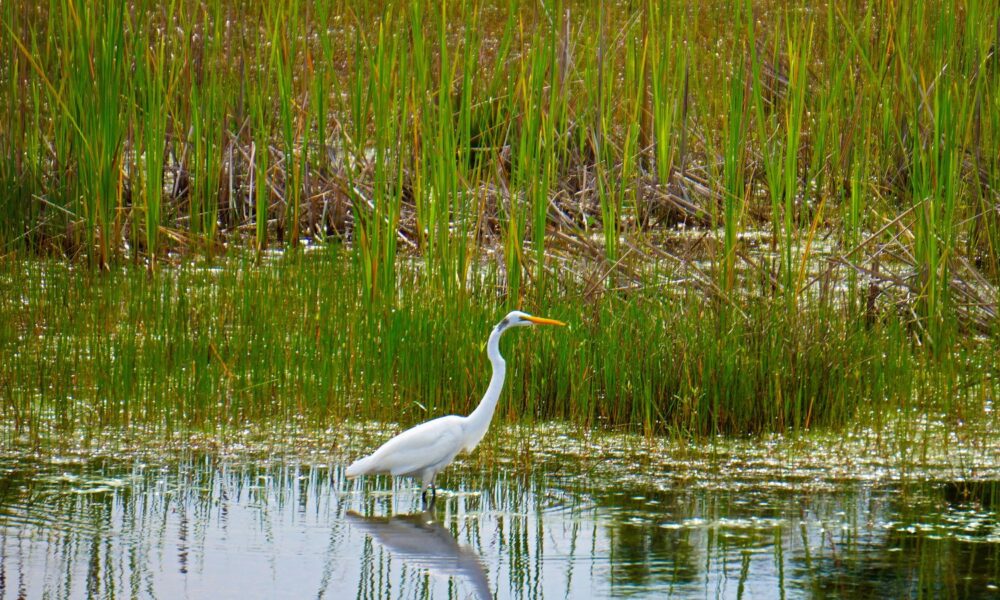The US Supreme Court’s recent undermining of wetlands protections in Sackett v. EPA could not have come at a worse time for our streams, rivers, and lakes. Now, only a week after the high court removed tens of millions of acres of wetlands from federal protection, a major study in the journal Nature found that human activities on Earth are breaching ecological limits for a host of vital systems.
One key system is water.
According to the study by more than 40 researchers for the Earth Commission, less than half the world’s population now benefits from easy access to free flowing rivers that sustain biodiversity and nourish healthy fisheries, which in turn support local economies. That is because too many rivers are altered by dams and development. Only 23 percent of the world’s large rivers (more than 620 miles in length) flow uninterrupted into the ocean.
Under the Earth’s surface, groundwater levels in nearly half the world’s basins are in decline from overuse. Invisible from above, groundwater is a critical source of drinking water, providing the base flow for rivers and, as the study said, “directly sustain[ing] wetlands and terrestrial vegetation.”
Compounding that are unsustainable levels of nitrogen and phosphorous runoff into rivers, lakes, and coastline estuaries from fertilizers. The runoff can trigger a tragic process known as “eutrophication,” leading to major fish kills and aquatic dead zones.
While much of the concern about climate change is understandably centered on staying beneath a threshold of temperatures that will unleash catastrophic climate impacts, the study is a reminder that there is much more to the preservation of the planet. A lead author, Joyeeta Gupta, told the media that if Earth was undergoing a medical exam, “Our doctor would say the Earth is really quite sick right now, in many areas.”
Earth Commission co-chair Johan Rockström added in a press release, “Unless a timely transformation occurs, it is most likely that irreversible tipping points and widespread impacts on human well-being will be unavoidable.”
Earth’s sickness lost on the Supreme Court
None of that appeared to be on the mind of the Supreme Court in Sackett v. EPA. The case involved an Idaho couple who wanted to develop over a wetland on their property near a lake; all nine justices on the high court concurred that the EPA went too far in regulating the particular wetland on the couple’s property.
But a razor-thin 5-4 majority, led by Justice Samuel Alito, seized on the case to gut a key portion of the 1972 Clean Water Act itself, ruling that the Environmental Protection Agency (EPA) can enforce environmental laws under the Clean Water Act only if a wetland is “indistinguishable” from larger bodies of water, with a “continuous surface connection” that has “no clear demarcation.”
The ruling by Alito and fellow Justices John Roberts, Clarence Thomas, Neil Gorsuch, and Amy Coney Barrett willfully ignored the overwhelming scientific evidence showing the connections between wetlands and downstream waters, and the fact that wetlands play an outsized role in biodiversity, despite covering only 5.5 percent of land in the contiguous 48 states.
The ruling ignored findings by the EPA that our own waters mirror the state of those around the world: they are quite sick right now. According to the EPA’s 2017 National Water Quality Inventory Report issued to Congress, nearly a third of wetlands and nearly half of the nation’s river and streams are in “poor biological condition.” More than 30 years ago, the US Fish and Wildlife Service reported to Congress that the nation has lost more than half of the wetlands that existed in colonial times in the contiguous 48 states.
The Supreme Court’s ruling was sadly predictable given that Alito wrote long ago that, as far as he was concerned, the EPA can step in to protect water only “when a pollutant is discharged directly from a point source to navigable waters.”
Also ridiculously predictable was who applauded the ruling most loudly and lined up to drive over the bridge to troubled waters: fossil fuel, mining, road building and agricultural polluters and commercial and residential developers who desire minimal regulation when plowing over the landscape. In its friend of the court brief in the Idaho case, the American Petroleum Association, the American Gas Association, and the Association for Oil Pipelines complained that the Clean Water Act led to a permitting system so “onerous” that the failure to obtain a permit after years of waiting “can be ruinous.”
Wetland connectivity proven long ago
Actually, polluters want to leave science-based permitting in ruins. The EPA under both the George W. Bush and Barack Obama administrations determined that wetlands are critically connected to the quality of drinking water and to the quality of larger bodies of water, even when one cannot see the connections on the surface. In a 2015 report based on 1,200 peer-reviewed publications, the EPA cited “ample evidence” that many wetlands that lacked surface water connections still “provide physical, chemical, and biological functions that could affect the integrity of downstream waters.”
The functions, such as filtering pollutants, absorbing storm surges, slowing floods, preventing erosion and being protective nurseries for fish, add up to being almost priceless. Wetlands saved the 12 states ravaged by Hurricane Sandy from an additional $625 million in damage, according to a study by researchers from the University of California Santa Cruz and the Nature Conservancy. More than half of the nation’s $5.6 billion commercial seafood bounty in 2018 came from fish (such as salmon) and shellfish (such as crabs and shrimp) which spend part of their lifecycle in wetlands, according to NOAA.
Most people understand this. Two-thirds of respondents told the Pew Research Center in 2020 that the federal government is doing too little to protect the water quality of lakes, rivers and streams.
Accelerating wetland losses
In making its ruling in Sackett v EPA, the Supreme Court was oblivious to the fact that the world has lost a third of its wetlands since 1970. Wetlands are disappearing faster than forests, according to the Ramsar Convention on Wetlands. The high court has set the stage for the United States to lose tens of millions of acres more. Environmental groups say the ruling in Sackett v EPA is so sweeping, that the result may be even worse than when the Trump administration tried to gut the Clean Water Act in 2019.
At that time, nearly four dozen current and former federal scientists filed a complaint with the EPA’s inspector general, warning that 40 million acres of wetlands, equivalent to the size of Wisconsin, would be removed from protection—a massive chunk of the nation’s 110 million acres of wetlands in the contiguous 48 states.
It appears that this slim Supreme Court majority wants to open the floodgates to polluters even as we continue to learn more about just how connected wetlands are to bigger bodies of water and also to our entire way of life. A Canadian study two decades ago found that degraded water from human land use could be detected in wetlands up to two and a half miles away. That study concluded: “Effective wetland conservation will not be achieved merely through the creation of narrow buffer zones between wetlands and more intensive land-uses. Rather, sustaining high wetland water quality will require maintaining a heterogeneous regional landscape containing relatively large areas of natural forest and wetlands.”
In this latest case, the high court didn’t even bother with narrow buffer zones. Paired with last year’s ruling curtailing the EPA’s powers to curb the carbon emissions fueling global warming, Alito and his majority are further disconnecting our nation from the science that could help us heal the planet.
The evidence could not be clearer that the Earth really is quite sick. Rather than aiding its recovery, this US Supreme Court seems intent on scurrying around the hospital, ward by ward, bed by bed, unplugging every life-support system and vital-signs monitor it can.

